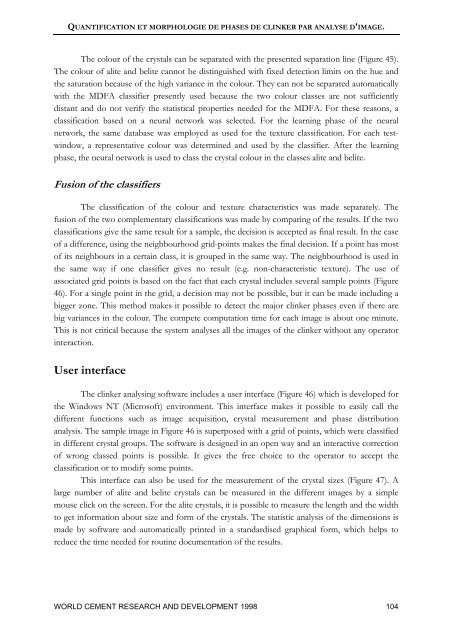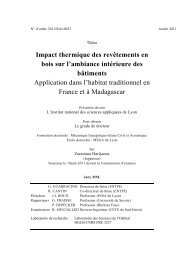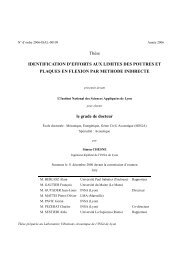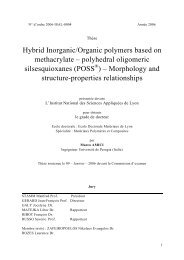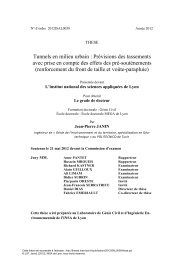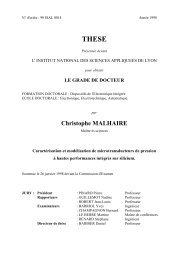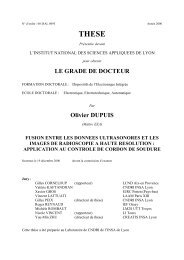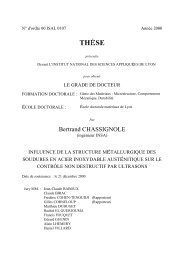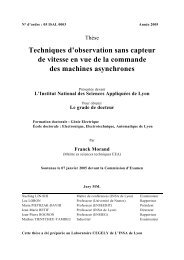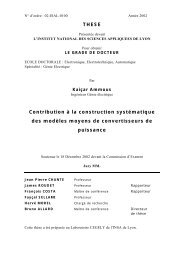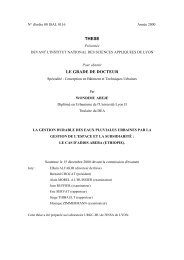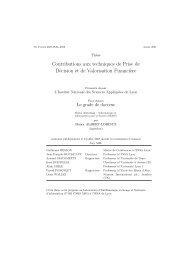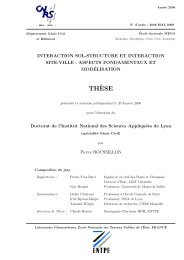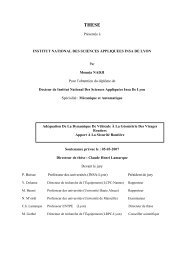Segmentation d'images couleur par un opérateur gradient vectoriel ...
Segmentation d'images couleur par un opérateur gradient vectoriel ...
Segmentation d'images couleur par un opérateur gradient vectoriel ...
Create successful ePaper yourself
Turn your PDF publications into a flip-book with our unique Google optimized e-Paper software.
QUANTIFICATION ET MORPHOLOGIE DE PHASES DE CLINKER PAR ANALYSE D'IMAGE.<br />
The colour of the crystals can be se<strong>par</strong>ated with the presented se<strong>par</strong>ation line (Figure 45).<br />
The colour of alite and belite cannot be distinguished with fixed detection limits on the hue and<br />
the saturation because of the high variance in the colour. They can not be se<strong>par</strong>ated automatically<br />
with the MDFA classifier presently used because the two colour classes are not sufficiently<br />
distant and do not verify the statistical properties needed for the MDFA. For these reasons, a<br />
classification based on a neural network was selected. For the learning phase of the neural<br />
network, the same database was employed as used for the texture classification. For each testwindow,<br />
a representative colour was determined and used by the classifier. After the learning<br />
phase, the neural network is used to class the crystal colour in the classes alite and belite.<br />
Fusion of the classifiers<br />
The classification of the colour and texture characteristics was made se<strong>par</strong>ately. The<br />
fusion of the two complementary classifications was made by com<strong>par</strong>ing of the results. If the two<br />
classifications give the same result for a sample, the decision is accepted as final result. In the case<br />
of a difference, using the neighbourhood grid-points makes the final decision. If a point has most<br />
of its neighbours in a certain class, it is grouped in the same way. The neighbourhood is used in<br />
the same way if one classifier gives no result (e.g. non-characteristic texture). The use of<br />
associated grid points is based on the fact that each crystal includes several sample points (Figure<br />
46). For a single point in the grid, a decision may not be possible, but it can be made including a<br />
bigger zone. This method makes it possible to detect the major clinker phases even if there are<br />
big variances in the colour. The compete computation time for each image is about one minute.<br />
This is not critical because the system analyses all the images of the clinker without any operator<br />
interaction.<br />
User interface<br />
The clinker analysing software includes a user interface (Figure 46) which is developed for<br />
the Windows NT (Microsoft) environment. This interface makes it possible to easily call the<br />
different f<strong>un</strong>ctions such as image acquisition, crystal measurement and phase distribution<br />
analysis. The sample image in Figure 46 is superposed with a grid of points, which were classified<br />
in different crystal groups. The software is designed in an open way and an interactive correction<br />
of wrong classed points is possible. It gives the free choice to the operator to accept the<br />
classification or to modify some points.<br />
This interface can also be used for the measurement of the crystal sizes (Figure 47). A<br />
large number of alite and belite crystals can be measured in the different images by a simple<br />
mouse click on the screen. For the alite crystals, it is possible to measure the length and the width<br />
to get information about size and form of the crystals. The statistic analysis of the dimensions is<br />
made by software and automatically printed in a standardised graphical form, which helps to<br />
reduce the time needed for routine documentation of the results.<br />
WORLD CEMENT RESEARCH AND DEVELOPMENT 1998 104


